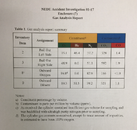Here is the data from the surface interval, which I posted earlier. It shows the ppO2 never dropped below 0.60. Stewart made two manual additions of O2 in the first minute, then took the mouthpiece out of his mouth (the data is consistent with witness testimony), closed the loop, and thereafter the rebreather's constant mass flow device continues to add a small amount of O2 periodically for the next two minutes and the ppO2 climbs gradually. While on the surface, Stewart was breathing either a high percentage of oxygen on the CCR or air, never hypoxic diluent.
The dive computer recorded the fourth dive (see attached).
Additional factors include hypotension, fatigue, the impact of rapid ascent, the impact of a prescription medicine whose side effects include fainting and low blood pressure, etc.






